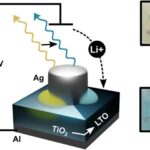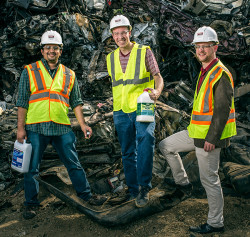‘Cary Pint’
“Dynamic Color Tuning with Electrochemically Actuated TiO2 Metasurfaces” published in Nano Letters selected as VINSE Spotlight Publication
Jun. 17, 2022—About the author: Janna Rathert recently completed a Ph.D. in Mechanical Engineering under the direction of Prof. Jason Valentine at Vanderbilt University and Prof. Cary Pint at Iowa State University. The collaboration between the Pint and Valentine groups seeks to explore ways in which electrochemical methods can be leveraged to reversibly modulate photonic devices, especially...
Dissertation Defense: Janna Rathert, Mechanical Engineering
May. 18, 2022—DISSERTATION DEFENSE Janna Rathert, Mechanical Engineering *under the direction of Dr. Jason Valentine & Dr. Cary Pint “Optimization of Ionic Transport in Electrochemical Devices” 05.25.22 | 11:00am CST | 132 Featheringill Hall | Zoom The increase in atmospheric greenhouse gas concentrations due to anthropogenic emissions poses imminent threats to Earth’s climate system and its most vulnerable...
Meet Our Graduates: Kate (Moyer) Vanderburgh
Apr. 17, 2022—Kate (Moyer) Vanderburgh graduated from the Vanderbilt University Interdisciplinary Materials Science Ph.D. program in December of 2019. Under the direction of Dr. Cary Pint, Kate worked on sustainably engineering electrode materials and additives for energy storage systems. She was an NSF GRFP recipient and summer 2018 intern at NASA Kennedy Space Center to investigate structural...
Meet Our Graduates: Anna Douglas
Jan. 25, 2022—Anna Douglas earned her Ph.D. in Interdisciplinary Materials Science at Vanderbilt University in 2019. While at Vanderbilt, Anna began her studies developing nanostructured materials that can improve the performance of energy storage devices including lithium and sodium ion batteries. During her graduate studies, Anna co-invented a novel electrochemical synthesis method to produce high quality carbon nanotubes from...
2019 VINSE Fall Faculty Celebration
Oct. 15, 2019—VINSE Director Sharon Weiss led the annual VINSE Fall Faculty Celebration yesterday afternoon, honoring our faculty’s highest achievements of the year. Sandra Rosenthal received this year’s Distinguished Service Award, for her leadership and dedication to advancing the missions of VINSE. Sandy served as VINSE Director for 12 years, stepping down in June. During Rosenthal’s tenure...
New method to fashion cheap, small carbon nanotubes ‘could change the world,’ Pint says
May. 24, 2018—Imagine a box you plug into the wall that cleans your toxic air and pays you cash. That’s essentially what Vanderbilt University researchers produced after discovering the blueprint for turning the carbon dioxide into the most valuable material ever sold – carbon nanotubes with small diameters. Cary Pint (Vanderbilt University) Carbon nanotubes are supermaterials that...
NSF equipment grant expands nanoscale research capabilities
Oct. 24, 2017—An advanced tool to be housed at Vanderbilt Institute for Nanoscale Science and Engineering core facilities will allow researchers to deposit uniform, ultrathin films for microelectronics, energy conversion devices and biomaterials. A $600,000 grant from the National Science Foundation’s Major Instrumentation Program is acquiring an ALD – atomic layer deposition – system. Jason Valentine, associate...
Pint featured in Forbes and Vanderbilt Research News
Nov. 9, 2016—How Scientists Turned Junkyard Scrap Metal Into A Battery Inspired by an archaeological find, researchers have built a pill-bottle-sized battery starting from junkyard scrap metal. The scientists say their approach could someday be used to repurpose metal alloys commonly found around the house for energy storage applications. As renewable energy sources like solar become a...
How to make electric vehicles that actually reduce carbon
Mar. 3, 2016—An interdisciplinary team of scientists has worked out a way to make electric vehicles that only are not only carbon neutral but carbon negative, capable of actually reducing the amount of atmospheric carbon dioxide as they operate. They have done so by demonstrating how the graphite electrodes used in the lithium-ion batteries that power electric...
Quantum dots made from fool’s gold boost battery performance
Nov. 11, 2015—If you add quantum dots – nanocrystals 10,000 times smaller than the width of a human hair – to a smartphone battery it will charge in 30 seconds, but the effect only lasts for a few recharge cycles. However, a group of researchers at Vanderbilt University report in the Nov. 11 issue of the journal ACS Nano that they...










